By Zach Wright, Director + Head Coach of Team Touchstone. Header photo by Jason Chang.
Team Touchstone just returned from Philadelphia, where 7 of our team climbers competed at the USA Climbing Sport & Speed National Championships. It was a wonderful experience full of fun and challenges, and we want to give you a rundown of the event and how our team did.
Sport & Speed Nationals is a unique beast: climbers compete in two disciplines for up to four days among 500 of the best youth climbers from around the country. Forgetting the difficulty of the climbing for a second, try to appreciate how cruxy this is from a purely logistical standpoint: you have 500 kids (10 age/gender categories of 50 kids each) plus their parents, siblings, grandparents, dogs, etc. packed into a single gym. During the event, everyone is vying for spectating space, warm up space, and, at the most basic level, personal space. I imagine that if you zoomed in to the molecular level of a nuclear explosion, it would look similar to the inside of the gym during Nationals: high energy atoms, packed to maximum density, bouncing off each other and chaotically raging towards a distant, more stable equilibrium. In what little space exists between everyone in the gym, the air itself is saturated with excitement, emotion, and the palpable tension of the competition atmosphere. Or maybe that’s just the humidity in Philly. Either way, the air in there is thick.
The air itself is saturated with excitement, emotion, and the palpable tension of the competition atmosphere. Or maybe that’s just the humidity in Philly.
The first two days of the competition are qualifiers, where each category of 50 needs to compete on the same route in the same day. With approximately half of the total competitors in the gym at once, getting warmed up and making it to your route on time to climb can be challenging. And if you find yourself climbing 47th in your group of 50, you’re in for a long, long day.
The goal of the qualifying days is to test climbers on a variety of skills, movement, and terrain to whittle the categories of 50 down to 20 for the semi-final round. In these first two days, our Team Touchstone climbers had a wide spectrum of results; some of our climbers walked away from their qualifying routes in podium position, while others found themselves falling just outside of the top 20 placement needed to move on to semi-finals.
In sport climbing, where you only get a single attempt, your entire competition can be derailed by a single foot slip or error in route reading.
One thing that’s simultaneously thrilling and infuriating about competition climbing is that anything can happen on any given day. Especially in sport climbing, where you only get a single attempt, your entire competition can be derailed by a single foot slip or error in route reading. But this holds true for all of your competitors as well, and it makes for some seriously exciting (and sometimes dramatic) moments in competition. Essentially, this means that no one walks into the competition as a given winner; even current National Champions have to work their way through the qualifying rounds to earn their spots in the later rounds, and they are equally as vulnerable to sudden twists of fate as everyone else.
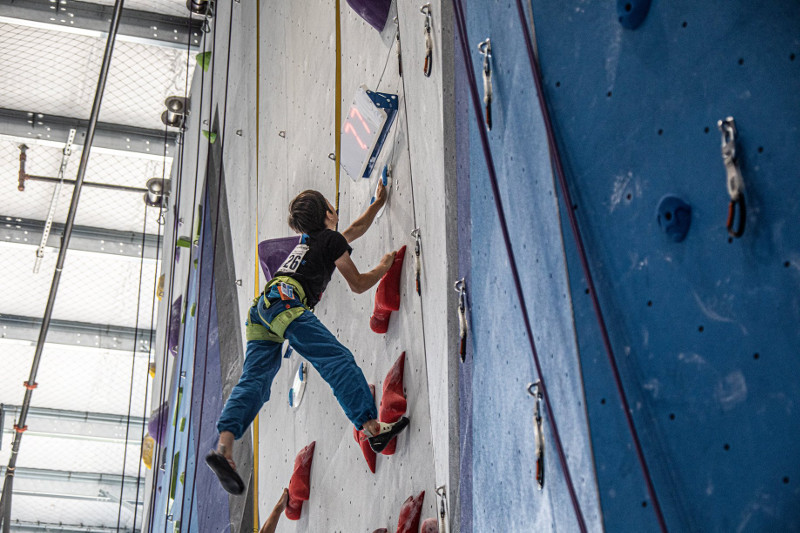
The first two days of the competition also include the speed climbing discipline, which is gaining a more mainstream popularity because of its inclusion in the Olympics. Speed, which is competed on a standardized wall and route, is not something we currently spend much time training on our team, since we don’t have a speed wall (imagine training for basketball without a hoop). Despite almost never training for Speed, it turns out that two of our younger girls are natural speed climbers: Noémie Nguyen and Analise van Hoang (both in the female 11 and under category) placed 2nd and 4th respectively in Speed finals, earning both of them a spot on the US National Team for Speed. This was a pleasant surprise for everyone (including them), as we have encouraged our climbers to participate in Speed as a means to become more well-rounded and gain additional competition experience, but we have not yet dedicated any serious training time to speed climbing.
At the higher levels of competition, it’s not about just showing up and giving a go on your route; it’s about managing yourself for the full extent of the comp.
After two days of Sport qualifying, three of our climbers finished outside of the top 20, meaning they wouldn’t be advancing to semi-finals. Two of them, Lewis Bittner (male 17-18 category) and Ronin Reeves (Female 13-14 category), were attending Nationals for their first time ever. The other, Lauren Berry (female 15-16 category) had attended a handful of Nationals before this year. It’s important to note that, whether it’s your first or tenth Nationals, or whether you advance to semi-finals or not, these things are not the ultimate measure of your experience. Even though you’re ultimately ranked against other people in competition, your experience boils down to what your make of it and what you take away from it. In the case of these three climbers, they showed up and put in excellent efforts for the full two days of qualifying. At the higher levels of competition, it’s not about just showing up and giving a go on your route; it’s about managing yourself for the full extent of the comp: dialing in your warmup, focusing on reading your route and internalizing the beta, dealing with your results, and maximizing your recovery for the next day. Whether you find yourself on top of the podium or finishing last in your category, this is the process that everyone has to go through, and making the most of this process is what competing is all about.
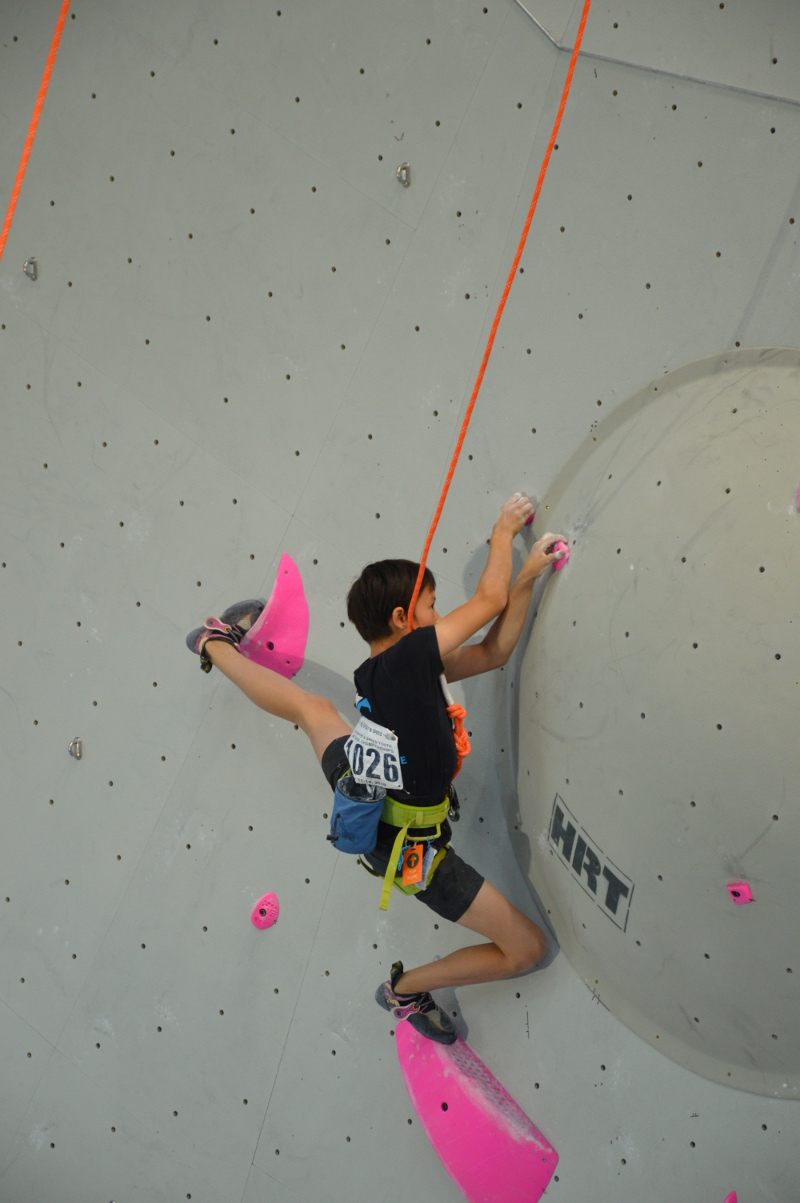
After qualifiers, four of our Team Touchstone climbers advanced to the semi-finals round, which is notorious for being the most physically demanding day of Nationals. It definitely lived up to the hype this year, featuring routes that were a substantial notch up in difficulty and intensity compared to the previous two days. For context, Analise and Noémie either finished or fell off the last hold of both of their qualifying routes. In semi-finals, they made it only 2/3 of the way up the route, but still found themselves placing in the top 4 for that round.
four of our Team Touchstone climbers advanced to the semi-finals round, which is notorious for being the most physically demanding day of Nationals.
The two other climbers who made semi-finals, Claudia Ryckebusch (female 13-14 category) and Leila Deschepper (female 17-18), also found themselves dealing with some stout semi-finals routes. We had two takeaways from this round of competition that I think are worth sharing:
Claudia found herself dealing with some extra adversity in this round of competition because during route preview (in which athletes are given a short period of time to review their routes—without coaches present—before climbing them), she ended up previewing the wrong route along with another girl from her category. She found out in the last minute of preview and had to scramble to read her actual route before coming back to the isolation area. Needless to say, this kind of thing happening in the middle of Nationals isn’t exactly a confidence booster. However, I was extremely impressed with her ability to make the most of the situation and regain her composure before competing.
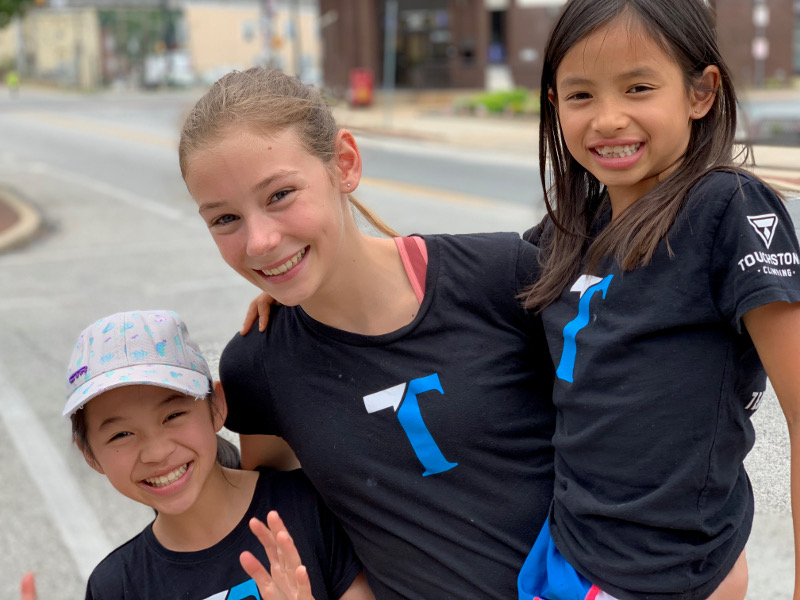
Luckily, Claudia had some help from a handful of girls in her category, who were happy to talk her through the beta for the route and share the insights they gleaned from the route preview. In the words of Vertical World Head Coach Tyson Schoene, who helped facilitate their discussion, “This is why climbing is the best sport there is.” Even though these girls were all technically competing against each other, there was no question that they would do everything they could to help her out in order to give her the best chance at succeeding on the route.
Even though these girls were all technically competing against each other, there was no question that they would do everything they could to help her out in order to give her the best chance at succeeding on the route.
Despite this setback in route preview, Claudia went out and gave a quality effort on her route, climbing well through most of it and falling off a bouldery move near the lip of the headwall. Her score tied her for 13th with several other girls in her category, putting her just outside of qualifying for finals. Though she was initially disappointed in not making finals, we emphasized that her performance was nothing to hang her head about; she climbed her route with an impressive level of quality, strategy, and commitment, which is always the goal in any competition. Ultimately, you can’t control how everyone else is going to place, so all you can do is focus on how you approach your route and how you understand your experience. In Claudia’s case, she exemplified the competition mindset that we teach to all of our climbers, and combined an excellent attitude with truly impressive climbing at the national level, which is a huge win in so many ways.
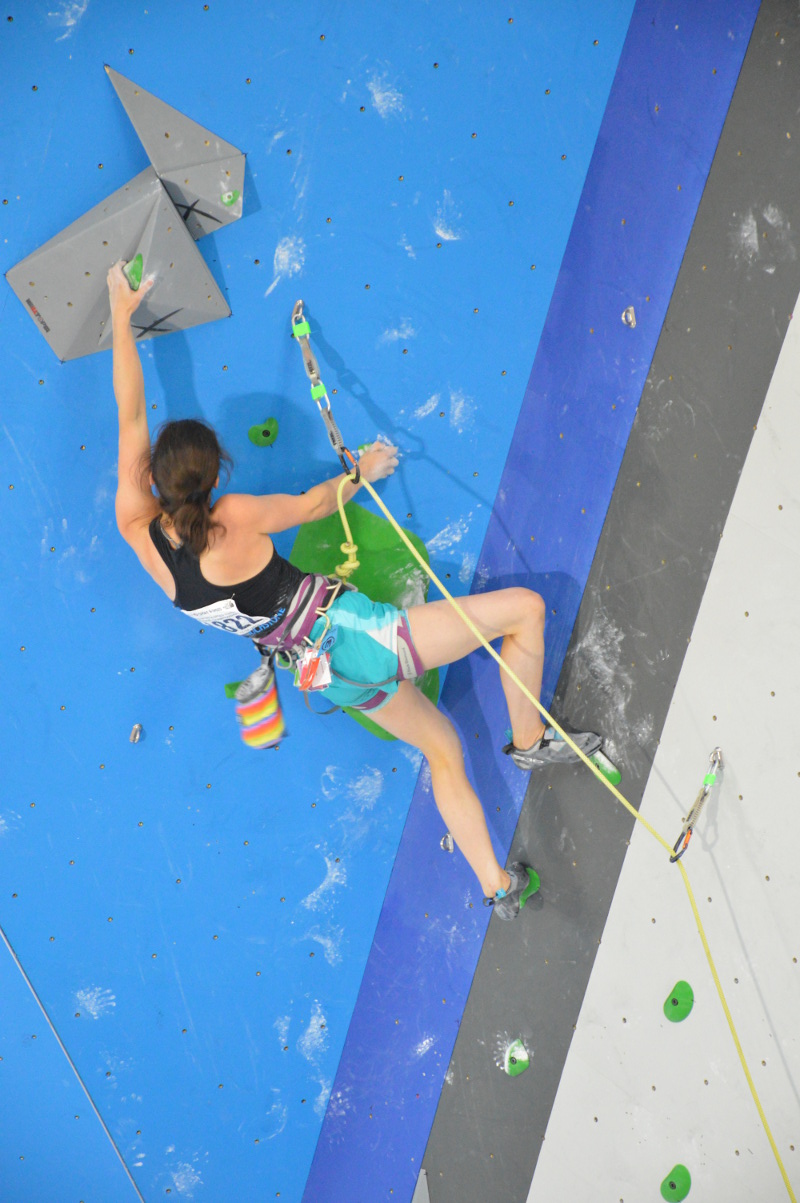
Leila had a standout performance on her semi-finals route, bumping her up from 18th place in qualifiers to 9th place in semi-finals and earning her a spot in finals the next day. Talking to her afterwards, she shared that her goal had been to finish somewhere in the top 15 at Nationals, so finding herself in finals was a surprise that exceeded her expectations for the competition.
Leila had a standout performance on her semi-finals route, bumping her up from 18th place in qualifiers to 9th place in semi-finals and earning her a spot in finals the next day.
In asking her what contributed to her performance on her route, she told me that prior to climbing, she wasn’t preoccupied with how other people were placing, how hard the route would be, or what her outcome would be. Essentially, she wasn’t focused on any of the external factors of the competition; she was focused on her personal performance and experience, which made a huge difference in how she was able to climb.
It may sound simple, but managing to tune out the externalities of the competition environment and climb 100% for yourself is a hard thing to do. Even small shifts in focus (e.g. “What if I fall here?”; “This foot is so bad”; etc.) can result in wasted energy, second-guessing, and getting flustered on your route. This is something we talk about frequently at our team practices, but until you experience it for yourself, it’s a hard thing to grasp. I was incredibly happy to hear that Leila had experienced this firsthand for herself, as this is a feeling that stays with you and is a valuable tool for future competitions and climbing challenges.
Something you don’t see as a spectator is the grind that these kids go through for each day of competition.
With three climbers going into finals, everyone was feeling the pressure to put in just one more day of quality competition climbing before finally getting a reprieve from the cumulative stress of the weekend. Something you don’t see as a spectator is the grind that these kids go through for each day of competition: they wake up early to come and sit in the isolation area for hours at a time before they can warm up. Sitting there, you do your best to relax, but you’re acutely aware of all the other competitors and how the round of competition is progressing. When it is time to warm up, it’s your fourth day in a row of climbing, you’re sore, and you have to muster another day’s worth of focus, intention, and effort in order to see the competition through. We wouldn’t be doing this if we didn’t absolutely love it, but it doesn’t change the fact that it can be grueling at times (especially the last day of Nationals).
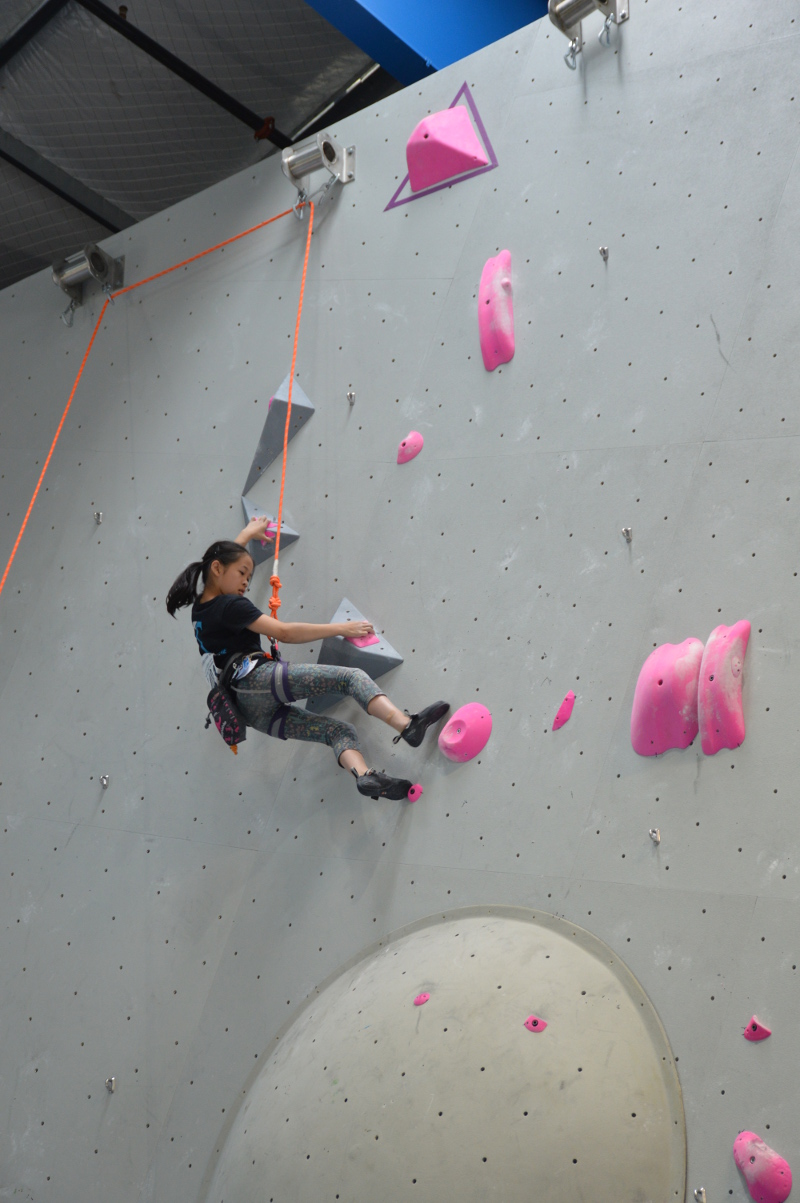
Our two youngest girls, Analise and Noémie, went into finals in 1st and 4th place respectively. They both podiumed at Bouldering Nationals last season, so they were familiar with the experience of climbing in finals and the associated intensity that comes with it. With the gym completely packed, Noémie came out first to tackle the technical, volume-featured route they were given for finals. She climbed the route with an excellent mix of technical precision and confidence, utilizing miserably bad hand- and footholds to make her way towards the top of the route. She found herself on the penultimate hold eyeing the finish and ended up coming just short of latching it, earning herself a near-top and guaranteeing herself at least 3rd place.
Our two youngest girls, Analise and Noémie, went into finals in 1st and 4th place respectively.
After watching the girl after Noémie top the route, we all knew that Analise would have to come out and onsight the route to maintain first place. It’s worth mentioning that on our team, we emphasize quality, effort, and learning over placements. The questions we’re interested in asking are: Did you have fun? How well did you climb? Did you challenge yourself? What did you take away from this experience? How will you use your experience to make yourself and your team better for next time? When we evaluate a climber’s performance, we ask whether you climbed well given your personal potential; we don’t ask if you climbed well compared to someone else, because that doesn’t measure anything that’s actually important to us as a team.
On our team, we emphasize quality, effort, and learning over placements.
That being said, we all knew that if Analise were to come out and climb with the quality and effort we know she’s capable of, she’d likely top the route. As much as we emphasize process over placements, we’re also realistic in that we recognize it’s cool to place well and be recognized for your efforts. So, I think we were all holding our breath to see if Analise would top the route because we knew she could, and because it would mean she’d walk away National Champion.
As it turned out, she did top the route and secured a first-place finish for herself, making her the back-to-back National Champion for both Bouldering and Sport.
As it turned out, she did top the route and secured a first-place finish for herself, making her the back-to-back National Champion for both Bouldering and Sport. Don’t get me wrong, we’re super proud of that fact, but we’re proud of it for the reason that we’re proud of everyone else who competed at Nationals: the goal in competition is to come in and be the best climber you can be in that moment. Not to be better than anyone else, but to be the best version of you. Doing this starts long before the competition rolls around, and it starts with putting in the hard work in practice. It involves working on your weaknesses, working on the things you’ve been avoiding, and failing over and over again. On the day of the competition, it involves dealing with all manner of adversity, whether it’s a crowded warm up area, an intimidating route, or the thoughts in your own head that make you second guess yourself. When you pull on the wall, it’s about giving 100% of yourself to your performance, and not letting the external factors interfere with your personal experience. We measure success to the extent that you can come into a competition and do these things, and that is why we’re proud of everyone who competed at Nationals this season.
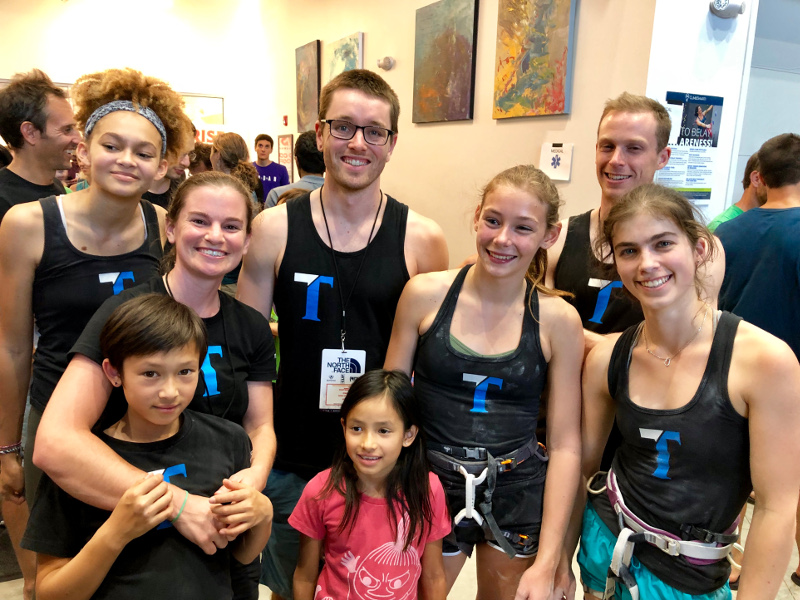
This season’s Nationals taught us more as climbers, coaches, and parents than any other competition I’ve been to.
From my perspective, this season’s Nationals taught us more as climbers, coaches, and parents than any other competition I’ve been to. What I’m most excited about is not how any of the individual climbers placed but how much this experience will help us grow as a team. For all of our climbers who were there, they learned lessons you can’t learn anywhere else, and they will bring that knowledge back to their team and incorporate it elsewhere in their lives. As coaches, we saw the lessons we teach on team in action at the highest level of competition; now the goal is to remember all the ways in which Nationals is challenging and prepare our climbers for that challenge every day in practice. As exciting as Nationals was, we’re already looking forward to next season, where we’ll get the chance to do this all over again and continue to grow as a team.

